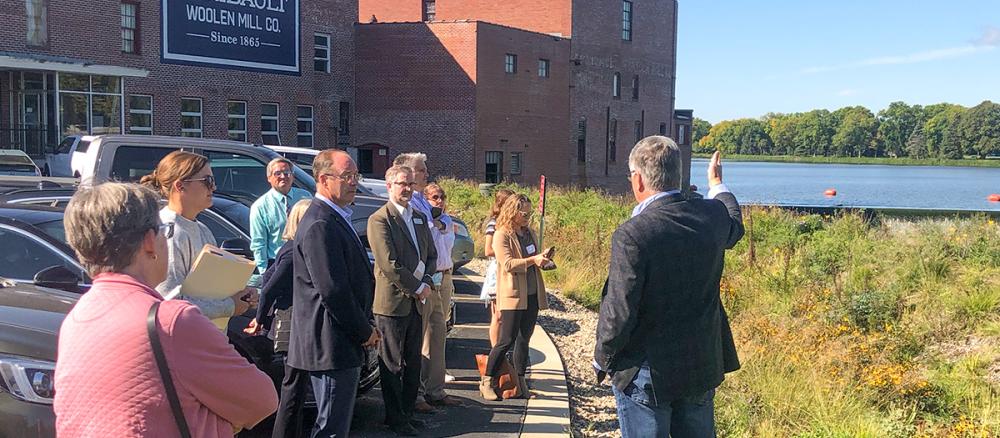The MPCA hosted events in Northfield and Faribault in celebration of Climate Week (September 20-26), to highlight the two communities' work on climate-change resiliency. State and community leaders advocated for the resources that communities and businesses need to make more climate-smart decisions and mitigate effects from increasingly extreme weather. The events also promoted the strategies that are helping Minnesota communities become more resilient in the face of climate change.
Planting trees
The release of carbon dioxide, a greenhouse gas that traps heat, is a primary driver of climate change. So planting trees, which absorb and store carbon dioxide, is great climate resiliency strategy. Trees also help mitigate flooding by slowing rain movement and storing and absorbing water. Planting native trees that have adapted to Minnesota is a best practice; they have the best chance of long-term survival.
State and city leaders planted a hackberry tree, which is native to southeastern Minnesota, next to “Love for All,” a mural by Jordyn Brennan. The artwork celebrates Faribault's diverse and accessible community, which offers features to accommodate deaf and blind individuals.
Installing rain gardens
The Faribault area has experienced several 500-year flood events in the past decade. At Faribault Woolen Mills, a flood damaged part of its building in 2010, and in 2013, another flood had staff filling and placing sandbags to keep rising water out. A couple of years later, another even larger flood threatened the community.
In 2018, the company worked with the Rice Soil and Water Conservation District to install a rain garden, including a large berm. The barrier keeps floodwaters away from the building and parking lot. Water collects in the rain garden and soaks into the soil, filtering out pollutants and recharging ground water. The process also helps improve water quality in the Cannon River.
“The rain gardens are truly better than any insurance plan we could have when it comes to flood protection,” Paul Mooty, co-owner and CFO of Faribault Woolen Mill Co., told state and city leaders during the tour.
Building flood mitigation projects
A heavy September 2010 storm caused Faribault's wastewater treatment plant to flood. The plant was offline for seven days, and the city was force to pump untreated sewage into the river. Some businesses were forced to close or cut way back on their water use to avoid causing further wastewater spillage. Other Minnesota communities besides Faribault have dealt with wastewater overflows caused by heavy rainfall and flooding; it's a growing concern as climate change worsens.
Thanks to funding included in last year's state bonding bill, the city was able to launch a flood mitigation project to keep river water from flooding the city's wastewater treatment plant. The city is set to complete the project by October.
Using low- or no-emission vehicles
Vehicle emissions, particularly from diesel engines, are a significant source of greenhouse gases and contribute to climate change. Vehicle emissions are also harmful to employee and community health. The U.S. EPA estimates that every dollar spent on reducing diesel emissions brings $13 in health benefits. So moving to electric, hybrid, or other alternative vehicles is a great strategy for both combating climate change and reducing harmful air pollution.
In 2019, MPCA grant funds helped Taylor Truck Line purchase the first all-electric terminal tractor in the state. It's used to move around semitrailers at Post Consumer Brands’ facility in Northfield. Swapping out the company's previous 2004-model diesel engine with electric cut Taylor’s yard emissions, eliminating 3.5 tons of nitrogen oxides, nearly a ton of particulates, and 112 tons of carbon dioxide each year.
